Author: Amrani Nurudini Samwaja
Youth Engagement to Address Climate Change through Mangrove Conservation, Restoration and Blue Economy at Bagamoyo,Tanzania.
Qn 1: What are mangroves and why are they important?
Mangroves are tropical trees that live in the coastal intertidal zone and can thrive in conditions most timber could never tolerate such in area with low oxygen soil, and coastal saline water Erftemeijer, (2022).
Why they are important, Mangroves of the Western Indian Ocean: status and management (Bosire et al., 2016) identified as the world is increasingly recognizing the critical role of blue carbon ecosystem to mitigate negative impacts of climate change. Mangroves act as natural carbon sink and a buffer between sea and land, protecting shorelines by preventing coastal erosion and mangroves contribute to restore and protect the biodiversity of marine and coastal ecosystems by providing feeding, breeding, as safe nursing grounds, habitats, nesting and migratory site for other aquatic species. Furthermore provide and support coastal communities on some livelihood such as fisheries, ecotourism and mangroves fruit-based product as a supplementary food sources.
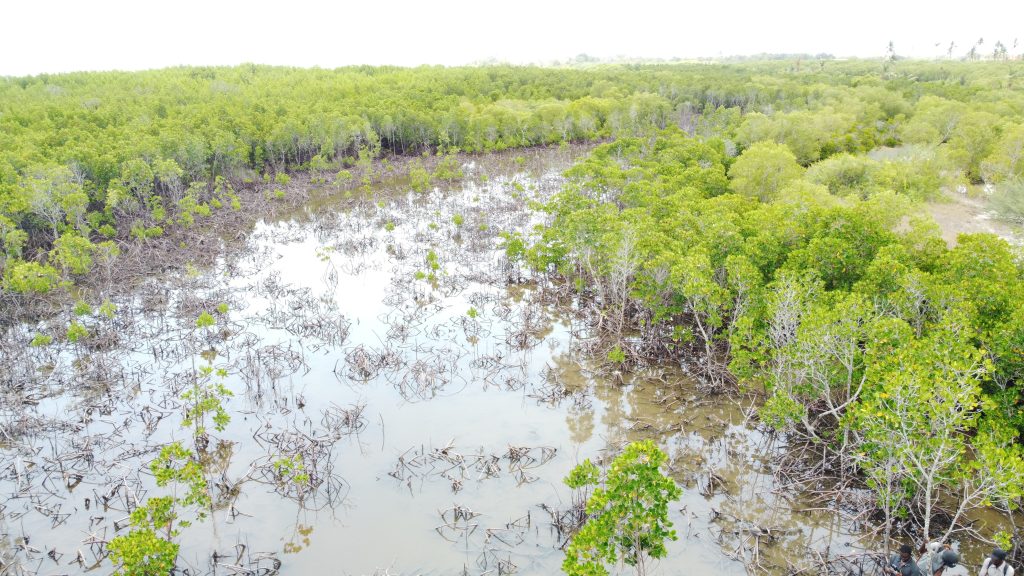
Qn 2: what are the causes of mangrove ecosystem destruction and how the ocean impacted due to mangroves loss?
According to Tanzania forest services (TFS) Agency identified and categorized drivers of mangrove deforestation and degradation as ecological threats includes floods resulting water level alteration, diversion of water courses, sand deposition from sea and land that cuts off portions of mangrove forest from salt water and sea-level rise as a result of climate change and socioeconomic threats include mangrove cutting to obtain fuel wood, pole cutting for sale in Dar es salaam and Zanzibar and mangrove areas are also cleared for salt pans in Bagamoyo, Tanga and Mtwara.
“Coastal community of Bagamoyo depends on mangrove forest to acquire their economic needs and livelihood`s requirements thus cutting mangrove for firewood, boat making, building materials and pole cutting for sale in Dar es salam and Zanzaibar.”
“Our ocean is negatively impacted due to mangrove deforestation as mangroves as act as a buffer between sea and land, so due to mangrove destructions; some marine species lost and other ecosystem like sea grass ecosystem and core reef ecosystem will be affected.”
Fadhili singo is a member of Beach management unit (BMU) Bagamoyo, he contributes on driving forces of mangrove destruction.
“The destruction of mangroves is contributing to coastal erosion, loss of livelihoods, loss of biodiversity, increase of environmental destruction and resulting global warming.”
Hillary Leornadi Maanga is a fisheries officer and leader chairperson of beach management unit (BMU) Bagamoyo district contributed on how ocean is impacted when mangrove forest destruction started.
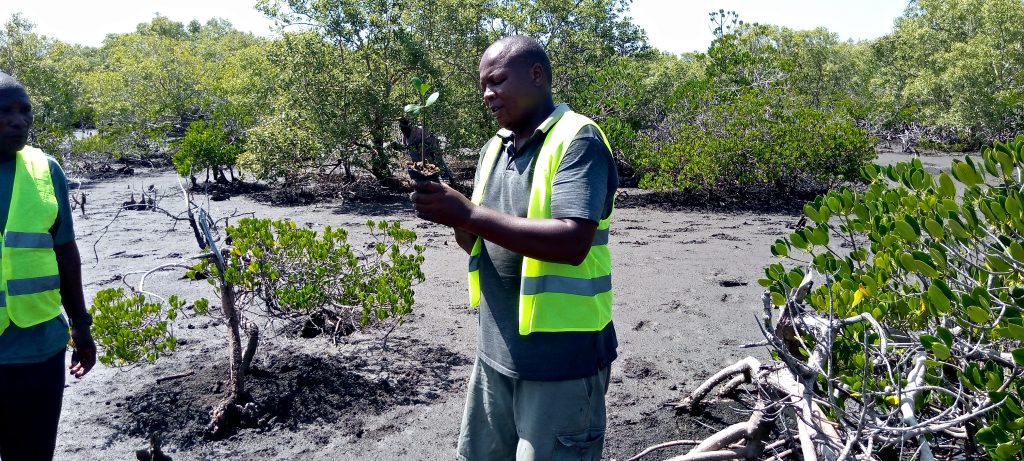
Qn 3. Describe the mikoko yetu project what is it about and what it aims? And when did it start?
SOA Tanzania is leading Mikoko yetu project that aims to restore the mangroves ecosystem of Bagamoyo,Tanzania and enabling the local coastal community of Bagamoyo,Tanzania to sustainably utilize the ocean`s natural resources through seaweed and sea cucumber farming. With the project goal of planting more than 20,000 mangroves to restore 128Ha of degraded mangroves of Bagamoyo,Tanzania to improve mangrove ecosystem as mangroves are important carbon sinks which help fight climate change through their carbon sequestration process.
SOA Tanzania initiated primary intervention used to address root causes of mangrove degradation these includes Establishing a Locally Managed And Protected Mangrove Forest (LMPMF),Mangrove planting SOA Tanzania uses a guideline set by WIOMSA and UNEP on mangrove restoration, empowering the community via community development projects and providing Ocean Literacy Knowledge integrating with the indigenous knowledge.
Mangrove forest in Bagamoyo,Tanzania has a Ruvu estuary which provides breeding, nursery grounds to 1000s of aquatic organism including mud skippers and migratory species so conserving this estuary means improving biodiversity of Ruvu estuary and protecting them.
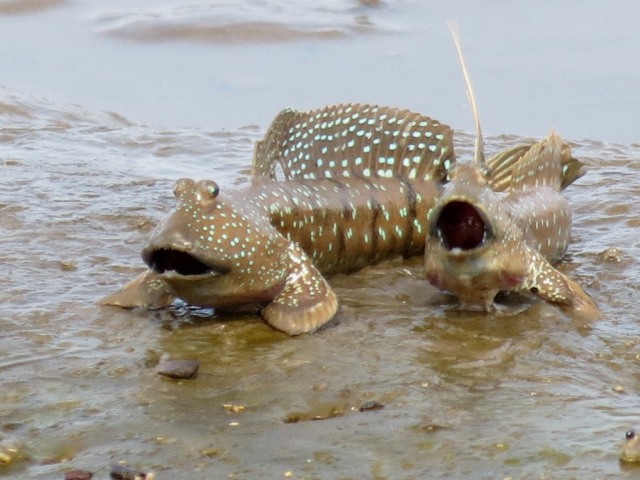
Qn 4: Describe the project location area including the size of the adopted forest in Bagamoyo and the rest of the areas and describe the causes of degradation of mangroves in Bagamoyo
Mikoko yetu Project located at Bagamoyo,Tanzania this was the capital of German East Africa by the German colonial administration and it became one of the most important trading ports for the Germans along the East African coast along the west of the Indian Ocean in the late 19th and early 20th century. Today, it is the capital of the Bagamoyo District in Pwani Region. Bagamoyo lies 75 kilometres (47 miles) north of Dar-es-Salaam on the coast of the Indian Ocean, across from the island of Zanzibar.
Currently in Bagamoyo, SOA Tanzania done a survey on total area of 3000Ha for conservation,128Ha mapped and 2872Ha unmapped for conservation and plan to scale the restoration area in other areas of Tanzania including Zanzibar to 500Ha of mangrove reforestation.
Causes of degradation of mangroves in Bagamoyo
1.Mangrove deforestation for timber and firewood -Since 2000 the local coastal community members of Bagamoyo have been harvesting the mangrove forest for timber and charcoal as source of their firewood and as an economic good where the timber from the mangroves were shipped to Zanzibar.
2. Salt mining: More than 10Ha of Bagamoyo,Tanzania mangrove forest has been cleared out due to salt mining brines construction and the whole activity. Since 2012 Bagamoyo,Tanzania had started to practice salt mining in their mangrove forests which greatly destroyed the mangrove forest and hinders natural regeneration of the mangrove forests.
3. Hydrological changes -Constructions of slat brines for salt mining are made in a way that the ocean waters are brought into the salt brines to dry and leave behind the salts. This activities have in turn changed the water hydrology of Bagamoyo,Tanzania mangrove forest and hampers the growth of the mangrove forests.
4. Fishing baits: Bagamoyo,Tanzania has over 500 people living under 1USD per day they solely depend on fisheries for their livelihood. Most fishermen use mangrove worms as fishing baits in their daily fishing activities. In their search for these mangrove worms they cut down mangroves neumatophores (mangrove roots) which as a result destroys the mangrove trees.
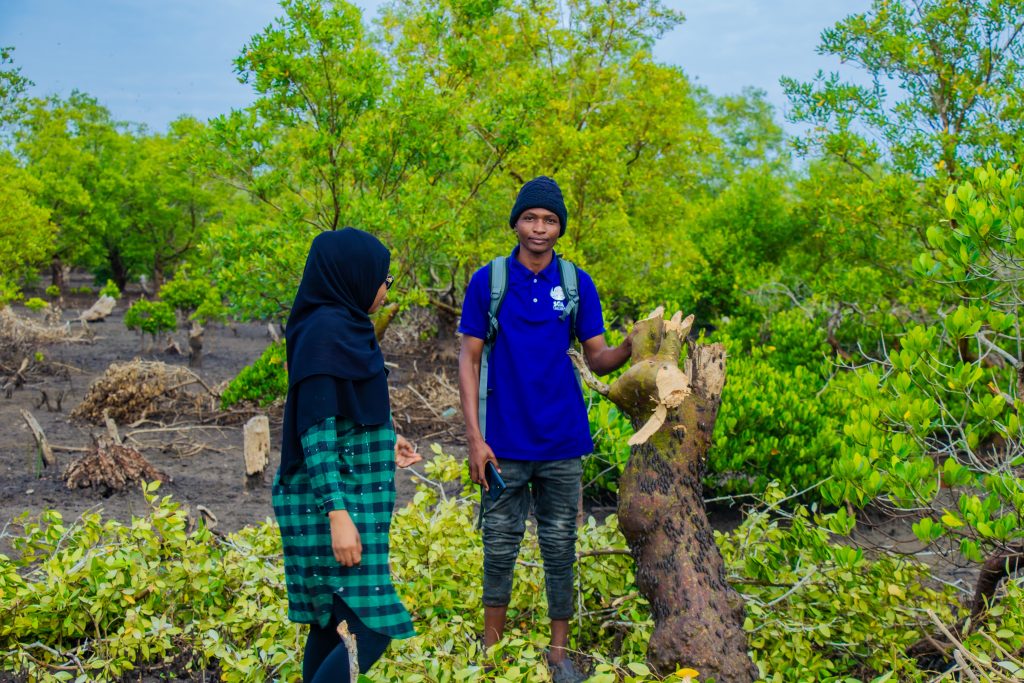
Qn 5: Describe the planting methodology and the planting work done since we started?
Mangrove planting SOA Tanzania uses a guideline set by WIOMSA and UNEP on mangrove restoration in the Western Indian Ocean region by establishing mangrove nursery to more than 20,000 baby mangrove trees as plating baby mangrove trees has proven to be more efficient with more survival rate than propagule planting.The project uses the mangrove restoration guideline set by the Western Indian Ocean Marine Science Association (WIOMSA) and the Nairobi Convection on mangrove restoration in the Western Indian Ocean Region, because Tanzania is part of the Western Indian Ocean Region. Link: Guidelines on Mangrove Ecosystem Restoration for the Western Indian Ocean Region – WIOMSA
Rhizophora mucronata, Aviccenia marina and Bruguiera gymnorrhiza were the dominant native species present in the areas and their current density have decreased by 80% percent and Bruguiera gymnorrhiza is at the most risk of extinction from the area. This project will restore and conserve all these native mangrove species
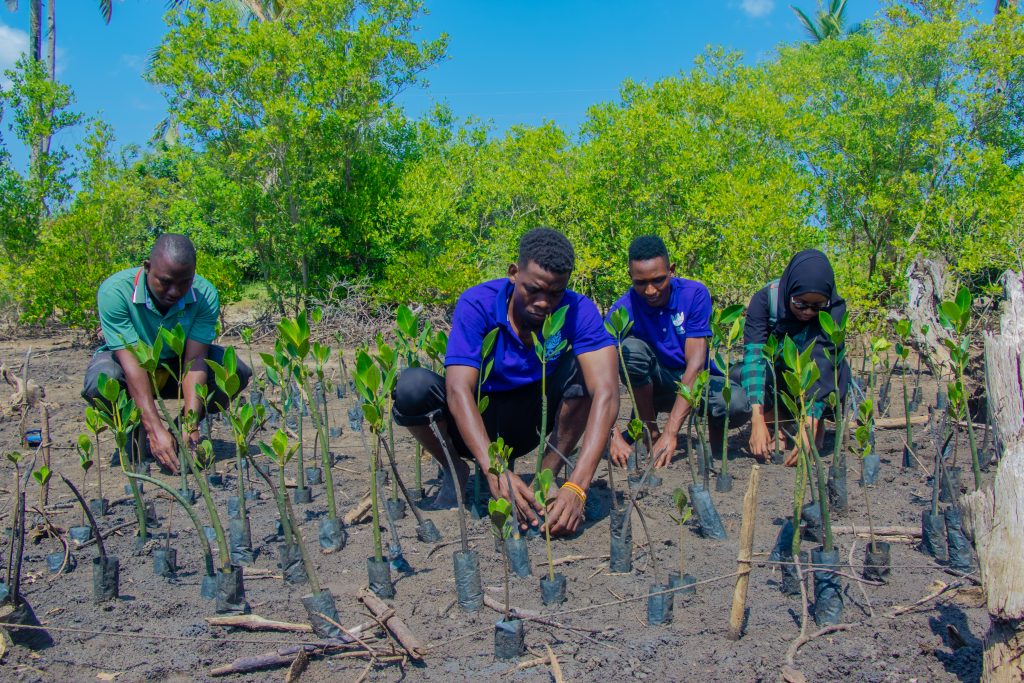
Qn 6: Describe how the local coastal communities are benefiting from the project?
Local people`s participation in (Mikoko yetu project) our mangrove restoration project will impacts their social capital as will contributes to increase social capital, improving their access to information and services because SOA Tanzania will endeavor to construct a Locally Managed and Protected Mangrove Forest (LMPMF), in which the adopted mangrove forest would be strictly preserved and managed by Bagamoyo, Tanzania’s indigenous coastal communities thus this project will improve sustainable fishing, seaweed farming,while other socioeconomic activities that will be done in this project includes
SOA Tanzania “MANGROVE HONEY -During this project, we will build 20 beehives within the LMPMF from which we hope to harvest mangrove honey, providing direct job to 20 local indigenous coastal people, SEAWEED FARMING -Bagamoyo people already have begun producing seaweed in a 1-hectare seaweed farm. During this project, we’ll give seaweed processing facilities and MANGROVE ECOTOURISM/LMPMF TOURISM -Bagamoyo is a tourist destination with over 200 visitors/year. This project will establish an MPA like Mangrove forest (LMPMF), beautiful estuary. 500 will be employed.”
Qn 7: Describe the role of youth in the project and how are they benefiting from the project?
As the world is increasingly recognizing the critical role of blue carbon ecosystems to mitigate negative impacts of climate change more attention is given to restoration and conservation of mangroves forests and is clearly linked to achieving multiple global goals including several sustainable development goals (SDGs) and the aim of the Paris Agreement to limit global warming to well below 2 degrees Celsius.
To address threats to mangroves, SO A Tanzania has recognized the essential role of youth in the mangroves conservation and restoration process as SOA TANZANIA is a youth lead organization with different education backgrounds aiming to empower young people and local coastal communities in Tanzania via ocean conservations and sustainable blue economy creating a health and sustainable ocean in our life time.
Mikoko yetu project benefiting youth and local communities through employment during and after the positive impacts of mangroves restoration thus contributes to increase social capital and through fishing, seaweed and sea cucumber farming activities as well as making our ocean health and sustainable.
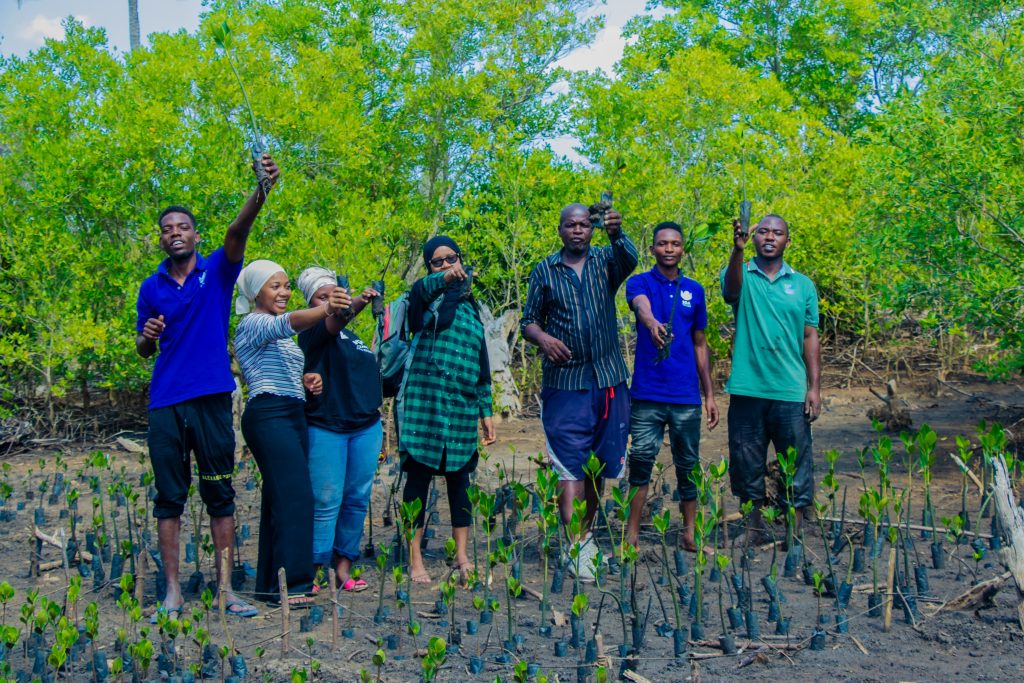
Qn 8: Describe the current needs for the project to scale up its implementation?
ENABLING COMMUNITY PARTICIPATION – Ensure community participationin the process of developing mangrove forest management plans and ensure a fair representation of community members in their implementation.This project will be scalable and systematically strengthen by improving relationship between coastal communities and mangroves ecosystems and ensure that coastal communities in Bagamoyo have economic incentives to maintain and safeguard these protective natural systems, without compromising their livelihood options. This will be achieved through community-led adaptation interventions, that include mangrove re-afforestation, conservation and livelihood diversification options (such as agroforestry, fish ponds, intensive gardening, fruit trees, developed through integrated community-based land use models and adaptation plans (such as the Forest-Fish-Fruit), this will lead successfully implementation of mikoko yetu(our mangroves ) project in Bagamoyo,Tanzania.
ENSURING LEGAL PROTECTION-Mangrove forests are legally recognized as state forest reserves in Tanzania, which gives management mandate to TFS so SOA Tanzania should legally establishing a Locally Managed and Protected Mangrove Forest (LMPMF),
Adequate funding is needed as seed capital to run the project and develop the community based developmental projects like seaweed farming, Bee keeping and mangrove ecotourism.
Qn 9: Describe the available governmental policies for mangrove conservation in Tanzania.
There are environmental laws and forest laws of Tanzania enforced by Tanzania Forest Security Agency including TANZANIA FOREST ACT OF 2002, which protects mangroves from deforestations.
Qn 10: How can people or organizations support the project?
There is a need to increase data on mangroves in Tanzania. Reliable and current information on coverage, status and land tenure has the potential to enhance the management of these ecosystems.
It is essential to strengthen awareness and building capacities among different stakeholders to understand the economic, social and environmental benefits of mangroves to facilitate volunteering and donors on mangrove conservation and restoration in Bagamoyo Tanzania.
Joint forces, donation and support of all kinds is needed to make this project positively impact our ocean and our coastal communities. Together we can restore the health and sustainability of our ocean for this and the next generation.
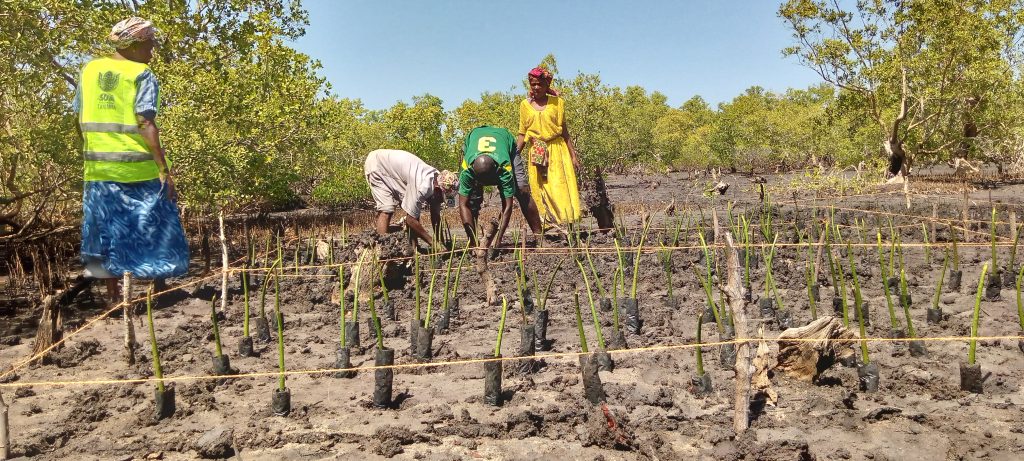
REFERENCES
Bosire, J., Mangora, M., Bandeira, S., Rajkaran, A., Ratsimbazafy, R., Appadoo, C. and Kairo, J. 2016. Mangroves of the Western Indian Ocean: status and management. WIOMSA, Zanzibar Town.
Mshale, B. et al. (2017). Governing Mangroves: Unique Challenges for Managing Tanzania’s Coastal Forests. CIFOR and USAID Tenure and Global Climate Change Program, Bogor, Indonesia and Washington, DC. 62pp.
Turpie, J. K. (2000). The Use and Value of Natural Resources of the Rufiji Floodplain and Delta, Tanzania. Rufiji Environment Management Project.
Monga, E., Mangora, M., Mayunga, J. (2018). Mangrove cover change detection in the Rufiji Delta in Tanzania. WIO Journal of Marine Science 17(2):1-10.
Mangora, M.M., Kamnde, K.J., Medard, M., Ndagala, J. and Japhet, E. (2021). Socio-economic Role of Mangroves and their Conservation Framework in Tanzania. WWF Tanzania, Dar es Salaam.
Erftemeijer, P. and de Boer, M. (2022). The State of Mangroves in the Western Indian Ocean. WWF, IUCN and Wetlands International.
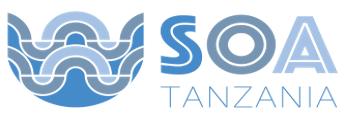
Thanks and congratulations for this strategy to mitigate the climate change, which is now becoming a challenge in every sector Agricultural sector together with fisheries.
Moreover, I would like to see on your publication the part of mangrove survival assessment techniques and how are we going to hand, this course the present challenge is we can rehabilitate, more seedlings even 30ha. But about 50% seedlings dies so when we comes up with alternative and after phasing out of project to identify the coverage and survival rate.
Thank you so much Simon for your contribution I will prioritize it thanks
Interesting project, in restoration of mangroves as responses to climate change. I think integration approach and community awareness are the great lance to rescue magroves equasystem
Thank you Holela.. exactly